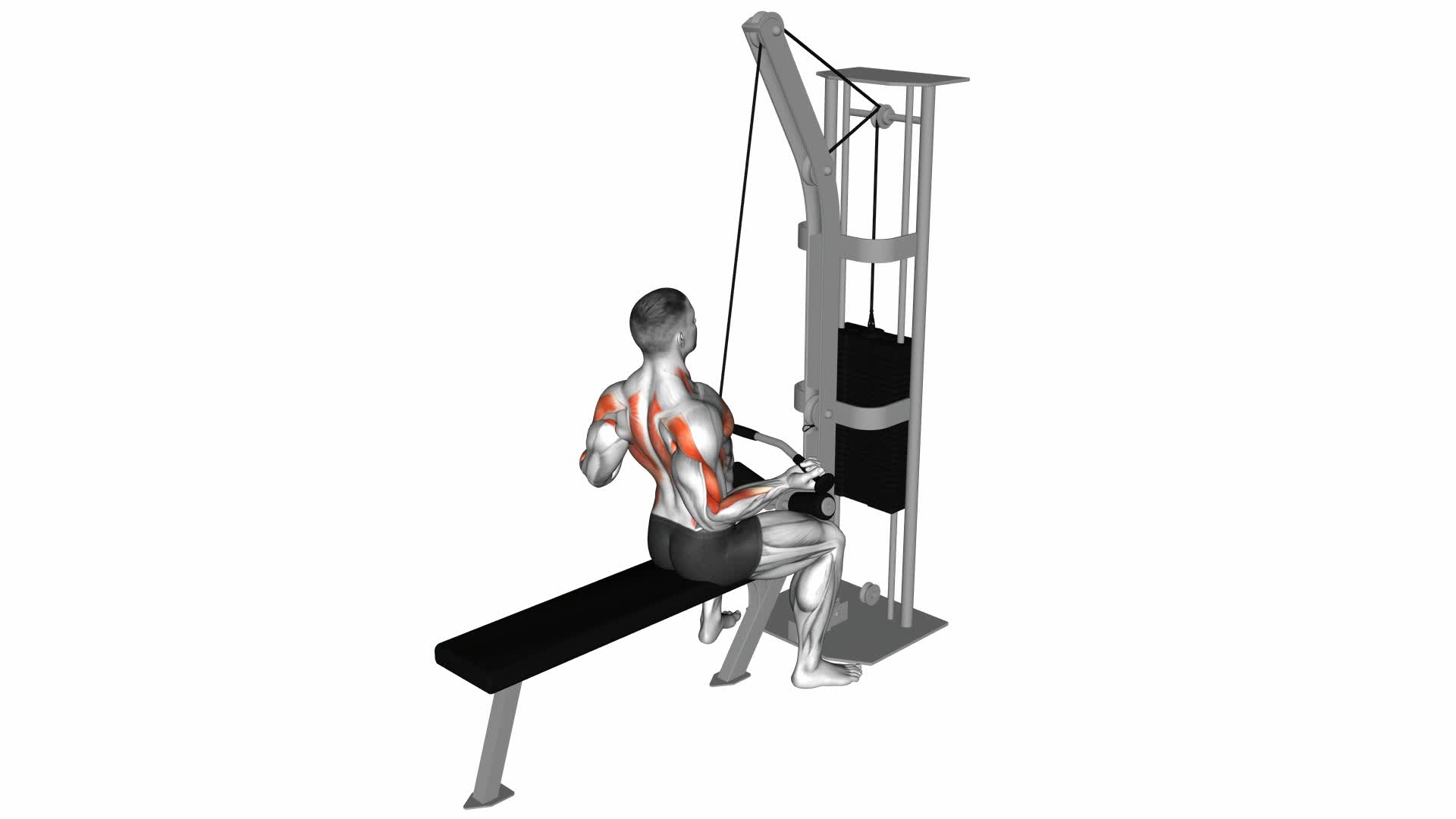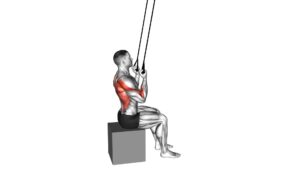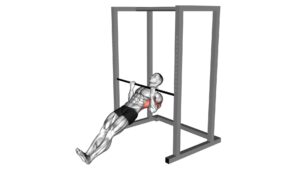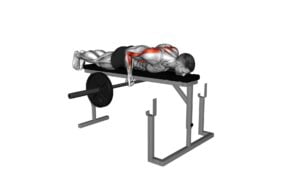Cable Underhand Pulldown – Video Exercise Guide & Tips

Are you looking to strengthen your upper body and build a strong back? Look no further than the cable underhand pulldown!
Watch This Exercise Video
This exercise targets your lats, biceps, and upper back, helping you develop a well-rounded physique.
In this video exercise guide, we'll walk you through the proper form and technique, common mistakes to avoid, and variations to challenge yourself.
Get ready to take your workouts to the next level with the cable underhand pulldown!
Key Takeaways
- Cable Underhand Pulldown targets lats, biceps, and upper back, helping to develop a well-rounded physique.
- Proper seat positioning and adjusting weight resistance is crucial for maintaining proper form and maximizing results.
- Varying grip width and engaging back muscles throughout the exercise are important for optimal muscle activation and development.
- Incorporating variations and progressions of Cable Underhand Pulldown adds variety to the workout routine, targeting different muscles and preventing plateaus.
Benefits of Cable Underhand Pulldown
Improve your strength and muscle gains with the Cable Underhand Pulldown, a highly effective exercise for targeting your back muscles. The Cable Underhand Pulldown is a popular exercise choice for individuals looking to strengthen their back and build muscle. It primarily targets the latissimus dorsi, or 'lats,' which are the large muscles that give your back a wide, V-shaped appearance. Additionally, this exercise also engages other muscles in the back, including the rhomboids, trapezius, and rear deltoids.
If you're looking for alternatives to the Cable Underhand Pulldown, there are a few options you can consider. One alternative is the Wide-Grip Lat Pulldown, which targets the same muscle groups as the Cable Underhand Pulldown but with a wider grip. This exercise can help to further emphasize the development of the lats. Another alternative is the Bent-Over Barbell Row, which targets the back muscles in a slightly different way. This exercise requires you to hinge at the hips and row a barbell towards your chest, engaging not only the lats but also the lower back and biceps.
Incorporating the Cable Underhand Pulldown into your workout routine can contribute to improved strength and muscle gains in your back. Consider adding this exercise, along with its alternatives, to your training program to target and develop your back muscles effectively.
Equipment and Setup for Cable Underhand Pulldown
To properly set up for the cable underhand pulldown exercise, you'll need to consider a few key points.
Firstly, choose the appropriate cable attachment option for this exercise, such as a wide bar or V-bar.
Next, ensure that your seat positioning is correct by adjusting it so that your knees are bent at a 90-degree angle and your feet are firmly on the floor.
Lastly, adjust the weight resistance on the machine to a level that challenges you without compromising proper form.
Cable Attachment Options
Choose the appropriate cable attachment for optimal performance and results during your cable underhand pulldown workout.
There are several cable attachment options available to enhance your grip strength techniques and target different muscles.
The most commonly used attachment for cable underhand pulldown is the straight bar attachment. This attachment allows for a wider grip, targeting the outer muscles of the back.
Another option is the V-bar attachment, which provides a closer grip and targets the inner muscles of the back.
If you want to focus on your biceps, you can use the rope attachment, which allows for a neutral grip.
Experiment with different cable attachments to find the one that suits your goals and preferences.
Now that you know about the cable attachment options, let's move on to discussing proper seat positioning for cable underhand pulldown.
Proper Seat Positioning
Sit on the cable machine seat with your feet firmly planted on the floor and your knees bent at a 90-degree angle. Proper seat positioning is crucial for performing the cable underhand pulldown exercise effectively and safely.
Start by adjusting the seat height so that your thighs are parallel to the ground when seated. This will ensure proper body alignment and allow for full range of motion during the exercise.
Additionally, make sure your back is straight, and your shoulders are relaxed. Avoid slouching or leaning forward, as this can put unnecessary strain on your lower back.
Adjusting Weight Resistance
Adjust the weight resistance on the cable machine for the cable underhand pulldown exercise by selecting the appropriate weight plate. Here's how you can make the necessary weight adjustments for an effective workout:
- Start with a lighter weight: If you're new to this exercise or unsure of your strength level, it's best to begin with a lighter weight. This allows you to focus on proper form and technique before gradually increasing the resistance.
- Increase the weight gradually: As you become more comfortable and proficient in the exercise, you can start adding more weight to challenge your muscles. Increase the resistance in small increments, such as 5 or 10 pounds at a time, to avoid straining or overloading your muscles.
- Listen to your body: Pay attention to how your muscles feel during the exercise. If you find that the weight is too heavy and you're struggling to perform the movement with proper form, it's important to decrease the resistance. On the other hand, if the weight feels too light and you can easily complete the exercise without feeling any tension, consider increasing the resistance for a more challenging workout.
Proper Form and Technique for Cable Underhand Pulldown
Now let's talk about the important points to keep in mind when performing cable underhand pulldowns.
First, the grip width variations can have a significant impact on targeting different muscles in your back.
It's crucial to avoid common mistakes like using excessive momentum or relying solely on your arms.
Grip Width Variations
To achieve proper form and technique for the cable underhand pulldown, it's important to vary your grip width. By adjusting the distance between your hands on the cable bar, you can target different muscles and maximize muscle activation.
Here are three grip width variations to consider:
- Wide grip: Placing your hands wider than shoulder-width apart targets the outer lats and helps to develop a wider back.
- Shoulder-width grip: Keeping your hands at shoulder-width apart emphasizes overall back development and provides a balanced workout.
- Close grip: Bringing your hands closer together focuses on the inner lats and helps to build thickness in the back.
Experiment with these grip widths to find the variation that works best for you and your fitness goals. Remember to maintain proper form and engage your back muscles throughout the exercise for optimal results.
Common Mistakes to Avoid
Avoiding these common mistakes is crucial for maintaining proper form and technique during the cable underhand pulldown exercise.
By doing so, you can avoid injury and maximize your results.
One common mistake to avoid is using excessive momentum. Many people tend to swing their bodies or use their lower back to pull the weight down. This not only reduces the effectiveness of the exercise but also puts unnecessary strain on your lower back.
Another mistake is using too much weight. It's important to choose a weight that allows you to maintain control and proper form throughout the movement.
Lastly, avoid pulling the bar behind your neck. This can put excessive stress on your shoulders and increase the risk of injury. Instead, focus on pulling the bar down towards your chest while keeping your elbows close to your body.
Benefits of Proper Technique
Maintaining proper form and technique during the cable underhand pulldown exercise is essential for reaping the full benefits and avoiding injuries. Here are the benefits of using proper technique for the cable underhand pulldown:
- Increased muscle activation: Performing the exercise with proper form ensures that the targeted muscles, such as the latissimus dorsi and biceps, are fully engaged. This leads to greater muscle activation and improved results.
- Injury prevention: Using correct technique helps to minimize the risk of injury. It ensures that the muscles and joints are moving in a safe and controlled manner, reducing the likelihood of strains, sprains, or other injuries.
- Improved strength and stability: Proper form allows for better recruitment of muscles and promotes stability throughout the exercise. This translates to increased strength and better overall performance in other exercises and daily activities.
Remember to maintain a neutral spine, keep your shoulders relaxed, and engage your core throughout the exercise for optimal results.
Common Mistakes to Avoid During Cable Underhand Pulldown
Make sure you're maintaining proper form while performing the Cable Underhand Pulldown exercise. Using improper technique can lead to overtraining risks and potential injuries. One common mistake to avoid is using too much weight. It may be tempting to add more weight to the cable machine, but if you can't perform the exercise with proper form, you're putting yourself at risk.
Another mistake is using momentum to pull the cable down. This takes away the focus from your back muscles and reduces the effectiveness of the exercise. Instead, focus on using your back muscles to initiate and control the movement.
Additionally, avoid rounding your shoulders or arching your back during the exercise. This can cause strain on your shoulders and lower back. Remember to keep your chest up, shoulders back, and engage your core throughout the movement.
By avoiding these common mistakes, you'll be able to maximize the benefits of the Cable Underhand Pulldown exercise and reduce the risk of injury.
Now, let's move on to the next section about variations and progressions for cable underhand pulldown.
Variations and Progressions for Cable Underhand Pulldown
To further challenge your back muscles and enhance the effectiveness of the Cable Underhand Pulldown, there are several variations and progressions you can incorporate into your workout routine.
These variations and progressions will help you target different muscles and add variety to your exercise routine. Here are three options to consider:
- Wide Grip Underhand Pulldown: Instead of using a shoulder-width grip, widen your grip on the cable bar. This variation places more emphasis on your lats and improves overall back strength.
- Close Grip Underhand Pulldown: Bring your hands closer together on the cable bar, with your palms facing you. This variation increases the focus on your biceps and helps develop a stronger mind-muscle connection.
- One-Arm Underhand Pulldown: Instead of using both arms, perform the exercise with one arm at a time. This progression challenges your core stability and increases the intensity on each side of your back.
By incorporating these variations and progressions into your Cable Underhand Pulldown routine, you can continue to challenge your muscles and avoid plateaus.
Now, let's move on to the next section and discuss some tips for incorporating cable underhand pulldown into your workout routine.
Tips for Incorporating Cable Underhand Pulldown Into Your Workout Routine
To maximize the effectiveness of your Cable Underhand Pulldown and integrate it smoothly into your workout routine, consider the following tips.
First and foremost, when incorporating the Cable Underhand Pulldown into your upper body workout, it's essential to maintain proper form. Ensure that your back is straight, shoulders are pulled back, and elbows are tucked in as you pull the cable towards your chest. This will engage your latissimus dorsi muscles effectively.
Additionally, it's recommended to start with a light weight and gradually increase the resistance as you become more comfortable with the exercise. This will help prevent injury and allow for proper muscle development.
If you're unable to perform the Cable Underhand Pulldown due to equipment limitations or any other reason, there are alternative exercises that target similar muscle groups. These include the seated cable row, bent-over dumbbell rows, and pull-ups. Incorporating these exercises into your routine can provide variety and help you achieve a well-rounded upper body workout.
Remember to listen to your body and adjust the weight and intensity accordingly. By following these tips, you can effectively incorporate the Cable Underhand Pulldown into your workout routine and achieve optimal results.
Frequently Asked Questions
How Many Sets and Reps Should I Do of the Cable Underhand Pulldown?
To get the most out of cable underhand pulldowns, it's important to know how many sets and reps you should do. This exercise targets your back muscles and can help improve your posture and upper body strength.
When it comes to sets and reps, it's recommended to start with 3 sets of 10-12 reps. As you become more comfortable, you can increase the weight and decrease the reps to challenge your muscles even more.
Can I Use a Different Grip for the Cable Underhand Pulldown?
Yes, you can definitely use a different grip for the cable underhand pulldown. There are various grip variations you can try to target different muscles and add variety to your workout.
The cable underhand pulldown offers unique benefits over other exercises, such as engaging the biceps and upper back muscles. It's a great exercise to strengthen your back, improve posture, and develop overall upper body strength.
Is the Cable Underhand Pulldown Suitable for Beginners?
The cable underhand pulldown is a great exercise for beginners looking to improve their overall upper body strength. It targets the muscles in your back, arms, and shoulders, helping you build strength and definition.
However, it's important to avoid common mistakes such as using too much weight, hunching your shoulders, or pulling with your biceps instead of your back. By following proper form and gradually increasing the weight, you can maximize the benefits of this exercise.
Are There Any Alternative Exercises That Target the Same Muscles as the Cable Underhand Pulldown?
If you're looking for alternative exercises that target the same muscles as the cable underhand pulldown, there are a few options you can try.
One option is the lat pulldown, which also works the back muscles.
Another option is the bent-over row, which targets the upper back and biceps.
Additionally, you can do pull-ups or chin-ups, which engage multiple muscle groups in the back and arms.
These exercises can be great alternatives to the cable underhand pulldown.
Can I Perform the Cable Underhand Pulldown Without a Cable Machine?
You can perform the cable underhand pulldown at home without a cable machine. This exercise targets your back muscles, specifically the latissimus dorsi.
Instead of using a cable machine, you can use resistance bands or even a towel. They'll provide the necessary resistance to work your muscles effectively.
The benefits of the cable underhand pulldown include strengthening your back, improving posture, and increasing upper body strength.
Conclusion
Incorporating cable underhand pulldowns into your workout routine can provide numerous benefits, such as strengthening your back muscles and improving your overall posture. By following proper form and technique, you can maximize the effectiveness of this exercise and avoid common mistakes.
Additionally, there are variations and progressions available to challenge yourself as you become stronger. Make sure to set up the equipment correctly and remember to consult a fitness professional if needed.
Start incorporating cable underhand pulldowns into your workouts for a stronger and healthier upper body.

Author
Years ago, the spark of my life’s passion ignited in my mind the moment I stepped into the local gym for the first time. The inaugural bead of perspiration, the initial endeavor, the very first surge of endorphins, and a sense of pride that washed over me post-workout marked the beginning of my deep-seated interest in strength sports, fitness, and sports nutrition. This very curiosity blossomed rapidly into a profound fascination, propelling me to earn a Master’s degree in Physical Education from the Academy of Physical Education in Krakow, followed by a Sports Manager diploma from the Jagiellonian University. My journey of growth led me to gain more specialized qualifications, such as being a certified personal trainer with a focus on sports dietetics, a lifeguard, and an instructor for wellness and corrective gymnastics. Theoretical knowledge paired seamlessly with practical experience, reinforcing my belief that the transformation of individuals under my guidance was also a reflection of my personal growth. This belief holds true even today. Each day, I strive to push the boundaries and explore new realms. These realms gently elevate me to greater heights. The unique combination of passion for my field and the continuous quest for growth fuels my drive to break new ground.







